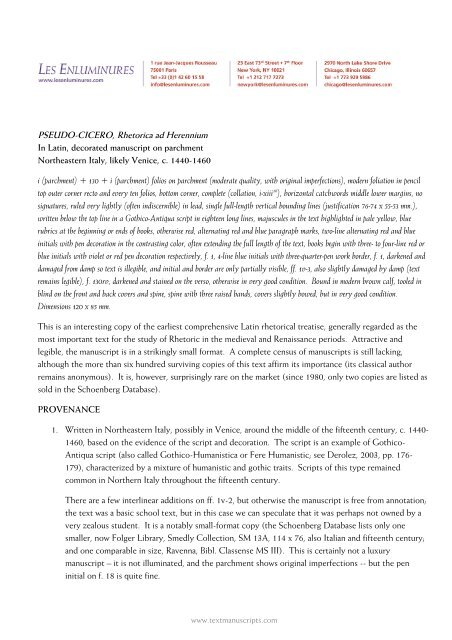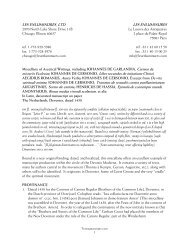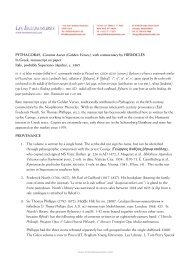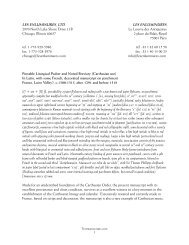PSEUDO-CICERO, Rhetorica ad Herennium In ... - Textmanuscripts
PSEUDO-CICERO, Rhetorica ad Herennium In ... - Textmanuscripts
PSEUDO-CICERO, Rhetorica ad Herennium In ... - Textmanuscripts
Create successful ePaper yourself
Turn your PDF publications into a flip-book with our unique Google optimized e-Paper software.
<strong>PSEUDO</strong>-<strong>CICERO</strong>, <strong>Rhetorica</strong> <strong>ad</strong> <strong>Herennium</strong><br />
<strong>In</strong> Latin, decorated manuscript on parchment<br />
Northeastern Italy, likely Venice, c. 1440-1460<br />
i (parchment) + 130 + i (parchment) folios on parchment (moderate quality, with original imperfections), modern foliation in pencil<br />
top outer corner recto and every ten folios, bottom corner, complete (collation, i-xiii 10 ), horizontal catchwords middle lower margins, no<br />
signatures, ruled very lightly (often indiscernible) in le<strong>ad</strong>, single full-length vertical bounding lines (justification 76-74 x 55-53 mm.),<br />
written below the top line in a Gothico-Antiqua script in eighteen long lines, majuscules in the text highlighted in pale yellow, blue<br />
rubrics at the beginning or ends of books, otherwise red, alternating red and blue paragraph marks, two-line alternating red and blue<br />
initials with pen decoration in the contrasting color, often extending the full length of the text, books begin with three- to four-line red or<br />
blue initials with violet or red pen decoration respectively, f. 1, 4-line blue initials with three-quarter-pen work border, f. 1, darkened and<br />
damaged from damp so text is illegible, and initial and border are only partially visible, ff. 1v-3, also slightly damaged by damp (text<br />
remains legible), f. 130rv, darkened and stained on the verso, otherwise in very good condition. Bound in modern brown calf, tooled in<br />
blind on the front and back covers and spine, spine with three raised bands, covers slightly bowed, but in very good condition.<br />
Dimensions 120 x 85 mm.<br />
This is an interesting copy of the earliest comprehensive Latin rhetorical treatise, generally regarded as the<br />
most important text for the study of Rhetoric in the medieval and Renaissance periods. Attractive and<br />
legible, the manuscript is in a strikingly small format. A complete census of manuscripts is still lacking,<br />
although the more than six hundred surviving copies of this text affirm its importance (its classical author<br />
remains anonymous). It is, however, surprisingly rare on the market (since 1980, only two copies are listed as<br />
sold in the Schoenberg Database).<br />
PROVENANCE<br />
1. Written in Northeastern Italy, possibly in Venice, around the middle of the fifteenth century, c. 1440-<br />
1460, based on the evidence of the script and decoration. The script is an example of Gothico-<br />
Antiqua script (also called Gothico-Humanistica or Fere Humanistic; see Derolez, 2003, pp. 176-<br />
179), characterized by a mixture of humanistic and gothic traits. Scripts of this type remained<br />
common in Northern Italy throughout the fifteenth century.<br />
There are a few interlinear <strong>ad</strong>ditions on ff. 1v-2, but otherwise the manuscript is free from annotation;<br />
the text was a basic school text, but in this case we can speculate that it was perhaps not owned by a<br />
very zealous student. It is a notably small-format copy (the Schoenberg Database lists only one<br />
smaller, now Folger Library, Smedly Collection, SM 13A, 114 x 76, also Italian and fifteenth century;<br />
and one comparable in size, Ravenna, Bibl. Classense MS III). This is certainly not a luxury<br />
manuscript – it is not illuminated, and the parchment shows original imperfections -- but the pen<br />
initial on f. 18 is quite fine.<br />
www.textmanuscripts.com
2. <strong>In</strong>side back cover, price code and dealers’ annotations in pencil; front flyleaf, f. i, title and date in a<br />
modern hand in pencil.<br />
TEXT<br />
ff. 1-130, [f. 1, damaged, text illegible] f. 1v, incipit, “//conquisiuerunt que nichil attinebant … hoc<br />
accumulantissime tue largiamur voluntati,” Marci Tuli C. Rhethoricorum explicit liber primus; f. 17v, <strong>In</strong>cipit liber<br />
secundum M. T. C. Rhethoricorum, incipit, “<strong>In</strong> primo libro herenni breuiter exposuimus … faciemus tue voluntati<br />
morem geramus,” Expleto libro secundo; f. 48v, Tertius incipit sequenter, incipit, “Ad omnem iudicialem … est<br />
ex[er]citatione confirma,” Explicit liber Tertius; f. 73, <strong>In</strong>cipit liber quartus, “Quoniam in hoc libro Hereni de<br />
elocutione … sed in ipsis rebus quandam habet dignitatem; f. 86v, Liber Quintus. De Repetitione, incipit,<br />
“Repititio est cum continenter …”; f. 109, <strong>In</strong>cipit liber sextus, De Distributione, incipit, Distributio est cum in plures<br />
… diligentia consequemur et exercitatione,” Deo Gratias M. T. C. Rethoricorum liber explicit vi [f. 130v, blank].<br />
<strong>Rhetorica</strong> <strong>ad</strong> <strong>Herennium</strong> (or Ad C. <strong>Herennium</strong> de ratione dicendi); the opening folio is damaged, so the text now begins<br />
imperfectly in the first chapter (line 14); it is divided into six books, with book five beginning in book 4,<br />
chapter 13, section 19, and book six in book 4, chapter 35, section 47 (these divisions also reported in other<br />
manuscripts; see Marx, 1964); important editions include, Achard, 1989 (with French translation), Calboli,<br />
1969, and Marx, 1923, reprinted 1964; English translation, Harry Caplan, 1954 (often reprinted). Between<br />
1475 and 1566 there were 183 editions of the text (most with Cicero’s De inventione), as well as eleven editions<br />
in Italian between 1475 and 1566 of three Italian translations.<br />
The text survives in more than six hundred manuscripts dating from the ninth century onwards (see<br />
discussion of textual families by Ruth Taylor-Briggs in Cox and Ward, 2006, pp. 77-108). There is no<br />
complete census of the surviving manuscripts, but John Ward and Ruth Taylor-Briggs have announced that<br />
they are compiling one, together with a census of commentaries and glosses on the text (see Ward, in Cox<br />
and Ward, 2006, p. 67, note 327).<br />
<strong>In</strong>terest in the Ad <strong>Herennium</strong> was particularly important in Italy from the thirteenth century on. It was<br />
translated into Italian as early as the thirteenth century (in abbreviated versions, the earliest complete<br />
translation in Italian is fourteenth century), and many of the surviving Latin manuscripts are of Italian origin,<br />
with a marked increase in numbers in the fifteenth century (see Cox in Cox and Ward, 2006, pp. 109-143).<br />
Classical rhetoric was important to the urban life of the independent city-republics in central and northern<br />
Italy, an interest that continued, although with different emphases, among the Italian humanists in the<br />
fifteenth century. Guarino Da Verona (1374-1460), for example, is said to have lectured on the <strong>Rhetorica</strong> <strong>ad</strong><br />
<strong>Herennium</strong> for more than thirty years, and his commentary on the text survives in more than twenty fifteenthcentury<br />
manuscripts and in six printed editions.<br />
The <strong>Rhetorica</strong> <strong>ad</strong> <strong>Herennium</strong>, the earliest comprehensive Latin rhetorical treatise, was written by an unknown<br />
author in the first century B.C. Together with the De inventione by Cicero (106 BC-43 BC), it was the most<br />
important text of the classical rhetorical corpus throughout the Middle Ages, and its influence continued into<br />
the Renaissance. From the fourth century it circulated as an accepted work by Cicero; some modern scholars<br />
have suggested that its author may be the author, Cornificius, mentioned by Quintilian, but this remains a<br />
hypothesis. As early as the Renaissance, in Italy in the 1480s, questions about its author were in fact alre<strong>ad</strong>y<br />
2<br />
www.textmanuscripts.com
aised. Some of these queries appeared in print for the first time in the1492 pamphlet by Raffaele Regio (c.<br />
1440-1520), Quaestio utrum ars rhetorica <strong>ad</strong> <strong>Herennium</strong> falso Ciceroni inscribatur (see Cox, 2003, pp. 684-686).<br />
Rhetoric can be defined simply as training in writing and delivering speeches; it was the primary form of<br />
higher education in the Ancient World. The Ad <strong>Herennium</strong> presented rhetorical theory in a concise, yet<br />
comprehensive manner, and its principles were easily <strong>ad</strong>apted to many different contexts (see Ward, 58-59),<br />
including texts on prose composition, letter writing, poetic composition, preaching, and political oratory. It<br />
also provided a basic introduction to both Roman, and with twelfth-century glosses, Canon Law. It presents<br />
the three genres of rhetoric as established by Aristotle, organized by the five necessary skills (invention,<br />
disposition, delivery, memory, style), and the six parts of the oration – Book four with its detailed examples of<br />
figures of speech was especially useful.<br />
Modern scholars now see Ciceronian rhetoric, and in particular the <strong>Rhetorica</strong> <strong>ad</strong> <strong>Herennium</strong>, as a text central to<br />
the intellectual history of the Middle Ages and the Renaissance. The importance of the tr<strong>ad</strong>ition of classical<br />
rhetoric throughout the Middle Ages and Renaissance has been convincingly argued in recent scholarly<br />
studies (see especially Cox and Ward, 2006), replacing the tr<strong>ad</strong>itional view that saw rhetoric as peripheral to<br />
the intellectual history of the Middle Ages – its influence restricted to treatises that provided instruction in<br />
letter writing (the ars dictamina) and indirectly, in manuals on preaching.<br />
LITERATURE<br />
Achard, Guy, ed. and tr. <strong>Rhetorica</strong> <strong>ad</strong> <strong>Herennium</strong>; Rhétorique à Herennius, Paris, Les Belles Lettres, 1989.<br />
Calboli, G., ed. Cornifici <strong>Rhetorica</strong> <strong>ad</strong> C. <strong>Herennium</strong>, introduzione, testo critic, commento, Bologna, 1969, 2 nd ed., Bologna,<br />
1993.<br />
Caplan, Harry, tr. Ad C. <strong>Herennium</strong> De ratione dicendi, Loeb Classical Library, Cambridge, Mass., 1954 (reprinted<br />
1964, 1968, 1977, 1981, 1989, 1999)<br />
Conley, Thomas. Rhetoric in the European Tr<strong>ad</strong>ition, New York, Longman, 1990.<br />
Cox, Virginia and John O Ward, eds. The Rhetoric of Cicero in its Medieval and Early Renaissance Commentary Tr<strong>ad</strong>ition,<br />
Leiden and Boston, Brill, 2006.<br />
Cox, Virginia. “Ciceronian Rhetoric in Late Medieval Italy,” in Cox and Ward, 2006, pp. 109-143.<br />
Cox, Virginia. “Rhetoric and Humanism in Quattrocento Venice,” Renaissance Quarterly 56 (2003), pp. 652-<br />
694.<br />
Derolez, Albert. The Palaeography of Gothic Manuscript Books from the Twelfth to the Early Sixteenth Century, Cambridge,<br />
Cambridge University Press, 2003.<br />
Kennedy, G. A. The Art of Rhetoric in the Roman World: 300 B.C.-A.D. 300, Princeton, 1972.<br />
Mack, Peter. A History of Renaissance Rhetoric, 1380-1620, Oxford and New York, Oxford University Press, 2011.<br />
Matsen, Patricia P., Philip Rollinson, and Marion Sousa. Re<strong>ad</strong>ings from Classical Rhetoric, Southern Illinois<br />
University Press, 1990.<br />
3<br />
www.textmanuscripts.com
Murphy, James J. Rhetoric in the Middle Ages: A History of <strong>Rhetorica</strong>l Theory from Saint Augustine to the Renaissance,<br />
Berkeley and Los Angeles, University of California Press, 1981.<br />
Marx, Fridericus, ed. <strong>Rhetorica</strong> <strong>ad</strong> <strong>Herennium</strong>. <strong>In</strong>certi auctoris De ratione dicendi <strong>ad</strong> C. <strong>Herennium</strong> lib. IV, Leipzig, 1923;<br />
reprinted under care of Winfried Trillitzsch, Leipzig, Teubner, 1964.<br />
Taylor-Briggs, Ruth. “Re<strong>ad</strong>ing between the Lines: the Textual History and Manuscript Transmission of<br />
Cicero’s <strong>Rhetorica</strong>l Works,” in Cox and Ward, 2006, pp. 77-108<br />
Taylor, P. Ruth. “Post-Classical Scholarship as Evidence of Textual Authority: The Expleti-Recension of the<br />
Ad <strong>Herennium</strong> Re-Examined,” Revue d’histoire des textes 25, 1995, pp.159-188.<br />
Ward, John O. Ciceronian Rhetoric in Treatise, Scholion and Commentary, Typologie des sources du Moyen Age<br />
occidental 58, Turnhout, Belgium, 1995.<br />
Ward, John O. “The Medieval and Early Renaissance Study of Cicero’s De inventione and the <strong>Rhetorica</strong> <strong>ad</strong><br />
<strong>Herennium</strong>: Commentaries and Contexts,” in Cox and Ward, 2006, pp. 3-75.<br />
Winterbottom, M. “De invention and Ad <strong>Herennium</strong>,” in L. D. Reynolds, ed. Texts and Transmission. A Survey of<br />
the Latin Classics, Oxford, Clarendon Press, 1983, 98-100.<br />
ONLINE RESOURCES<br />
Loeb edition of the Ad <strong>Herennium</strong>, Open Library<br />
http://archive.org/stream/<strong>ad</strong>cherenniumdera00capluoft#page/n65/mode/2up<br />
<strong>In</strong>troduction from Caplan’s 1954 Loeb edition<br />
http://penelope.uchicago.edu/Thayer/E/Roman/Texts/<strong>Rhetorica</strong>_<strong>ad</strong>_<strong>Herennium</strong>/<strong>In</strong>troduction*.html<br />
Gideon Burton, on the Ad <strong>Herennium</strong> (detailed outline), at the Silva <strong>Rhetorica</strong>e, an online introduction to<br />
rhetorical terminology and sources<br />
http://rhetoric.byu.edu/primary%20texts/Ad%20<strong>Herennium</strong>.htm<br />
On rhetoric in general, see<br />
http://rhetoric.byu.edu<br />
Schmidt, Peter L. “<strong>Rhetorica</strong> <strong>ad</strong> <strong>Herennium</strong>.” Brill’s New Pauly, Antiquity volumes edited by Hubert Cancik<br />
and Helmuth Schneider. Brill Online , 2012 (by subscription)<br />
http://www.brill.nl/publications/brills-new-pauly<br />
TM 613<br />
4<br />
www.textmanuscripts.com





